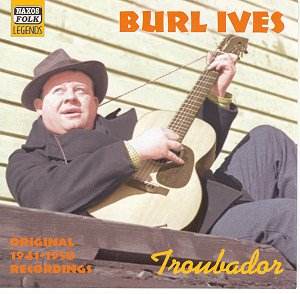 CD Reviews
CD Reviews MusicWeb
Webmaster: Len Mullenger
Len@musicweb.uk.net
[Jazz index][Purchase CDs][ Film MusicWeb][Classical MusicWeb][Gerard Hoffnung][MusicWeb Site Map]

Burl IVES (1909-1995)
Troubador: Original Recordings
1941-1950
Burl Ives, vocals and guitar
Tony Mottola, lead guitar
Toots Mondello, flute
Paul Ricci, clarinet
Bob Haggart, bass
All selections recorded in New York, NY between
1941 and 1950
Transfers & Production: David Lennick
![]() Naxos 8.120728 [66:38]
ADD
Naxos 8.120728 [66:38]
ADD
Crotchet Budget price
Wee Cooper O’ Fife - traditional [1:30]
Riddle Song – traditional [1:33]
Cowboy’s Lament (Streets of Laredo) – traditional [2:41]
Tam Pierce (Widdicome Fair) – traditional [2:17]
I Know Where I’m Going – traditional [1:32]
I Know My Love – traditional [1:42]
Peter Gray – traditional [2:33]
Sweet Betsy From Pike – traditional [1:44]
On Top of Old Smoky – traditional [1:39]
Darlin’ Cory – traditional [3:17]
Leather Winged Bat –traditional [1:21]
Cotton-Eyed Joe – traditional [0:51]
On Springfield Mountain – traditional [2:27]
Little Mohee – traditional [3:07]
Troubador Song – traditional [2:34]
Lord Randall – traditional [3:16]
Bonnie Wee Lassie – traditional [1:58]
Colorado Trail – traditional [0:50]
Rovin’ Gambler – traditional [1:44]
John Hardy – traditional [2:36]
The Divil and the Farmer – traditional [2:09]
High Barbaree – traditional [3:17]
Pretty Polly – traditional, arr. Burl Ives [3:13]
Pueblo Girl – traditional, arr. Burl Ives [1:17]
Baby Did You Hear – traditional, arr. Burl Ives [1:55]
Old Blue Ballanderie – traditional [0:31]
Robin, He Married– traditional, arr. Burl Ives [1:27]
Lavender Cowboy– traditional, arr. Burl Ives [1:20]
I’ve Got No Use for Women– traditional, arr. Burl Ives [3:09]
Old Paint– traditional, arr. Burl Ives [2:16]
Green Broom – traditional, arr. Burl Ives [2:57]Burl Ives is one of the definitive voices of American folk music. From the time after he returned from World War II until around 1962, when he went to Nashville as a country singer and became the voice of the snowman in Rudolph the Red Nosed Reindeer he was one of the most successful of the folk singers that would later inspire Bob Dylan, Joni Mitchell, David Crosby, Stephen Stills, Neil Young, and Graham Nash. He honed his trade in the 1930s traveling around America as a hobo, or in his words "a wayfaring minstrel". As far as the works of Burl Ives go, this is perfectly representative of the sounds that made his career.
The contents of this album are reissues of 3 previously released albums: The Wayfaring Stranger, The Return of the Wayfaring Stranger, and More Folk Songs, all recorded in New York, the first album by OKeh records in 1941, and the latter two by Columbia records between 1949 and 1950. The instrumentation is mostly solo guitar and voice, although the third album included several other traditional instruments with arrangements done by Burl Ives.
Unfortunately, either the original recordings were either in very bad shape or the transfer was not done with particular skill. The original tape hiss is evident throughout. Several of the tracks from the earliest recordings also show signs of tape splicing, probably to repair damaged recordings, and of noise that sounds introduced in the transfer. There is definitely noise from digital "overdrive" where the process involved introduced extra edge and buzzing on the louder parts of the recordings, most notably on the selections Peter Gray, Sweet Betsy From Pike, and Leather-Winged Bat. This is truly unfortunate, as Mr. Ives is clearly giving wonderful performances that would otherwise be lost to time.
That being said, there is often a lot of sound loss when tapes are improperly stored for decades. At least the recordings were preserved, and none are actually unlistenable. There is often a certain charm that the old recordings made with imperfect equipment have which, no matter what technical marvels today’s audio engineers can produce, is unmistakable and actually enhances the listening experience.
Should you be unfamiliar with the great Burl Ives, this album is a wonderful introduction. His voice is charming and hearkens to a simpler time. His delivery is genuine and velvety, gained through honest labor in rural Illinois and roughshod experience in America’s dust-bowl during the depression. Should you already know his material, you will know that these selections are certainly indicative of the simple beauty a folk song can convey. The transfer’s imperfections are the only negative, and this album certainly should be recommended to any lovers of folk music anywhere.
Patrick Gary